4.5. Use as aquafeed
Because of their relatively high protein content and abundance in tropical and sub tropical countries, a significant number of research studies have been carried out to find the potential for the utilization of water hyacinths as a fertilizer, for example by Sipauba-Tavares and Braga (2007) for the rearing of tambaqui (Colossoma acropomum), and as a fish feed in pond aquaculture.
Available literature indicates that water hyacinths are fed to fish either in fresh form, or as a dried meal in pelleted diets, or composted as feed and fertilizer. Apart from these three forms, attempts are
Table 4.2
Proximate composition and mineral content of water hyacinths

1 CP = crude protein; EE = ether extract; CF = crude fibre; NFE = nitrogen free extract; Ca = calcium; P = phosphorus
2 Leaves collected from a particular type of water hyacinth with a long and thin stem
3 Adjusted or calculated; not as cited in original publication
also made to feed water hyacinths to fish by processing them with other techniques. Many of these studies were conducted under laboratory conditions and reports of on farm utilization as fish feed are rather limited. Information on these topics has been grouped into several sections: four dealing with the various forms of water hyacinth (fresh, dried, composted and fermented, and other processing techniques), followed by comments on food conversion efficiency and digestibility.
4.5.1 Fresh form
Many researchers have investigated the use of water hyacinth in its fresh form. The high moisture content is a major constraint in its use as fish feed, which has proved to be unsuccessful in many cases. Hyacinth leaves are generally cut into small pieces and fed to grass carp or other macrophytophagous fish. Generally, grass carp feed on this plant only when no other macrophytes or feeds are available.
Riechert and Trede (1977) reported the results of a preliminary indoor laboratory trial carried out in Germany on the feeding of water hyacinths to grass carp. Eleven month old fish weighing 38 to 104 g were fed for 50 days exclusively on water hyacinths. Roots and leaves were accepted readily by the grass carp but the swollen petioles reluctantly. The fish grew well, producing 6.5 g live weight from 10 g DM hyacinth (FCR = 1.54). These authors also noted that grass carp above 80-100 g were better able to utilize hyacinth leaves compared to smaller fish and postulated that only 50-60 percent of the feed consumed was actually digested.
Tuan et al. (1994) used both fresh and fermented water hyacinth as supplementary feed in nursery ponds in Vietnam for fingerlings (1-6 g) of Nile tilapia, common carp, grass carp and Java barb. Fresh whole water hyacinth was chopped and mixed with rice bran at a ratio of 2:1 or 1:1 and fed to fish. A water hyacinth-rice bran mix was also fermented and fed. The growth of fish obtained by feeding the hyacinth-rice bran mixture was comparable to the growth obtained from rice bran alone. Rice bran is normally applied to nursing ponds in Vietnam. In terms of weight gain and specific growth rate, water hyacinths mixed with rice bran at a ratio of 2:1, either raw or fermented, could be used to replace rice bran in nursery ponds. Amongst the four species used, Nile tilapia performed better than the other species, exhibiting a specific growth rate of 4.3-4.8 percent/day. The specific growth rates of grass carp, Java barb and common carp were 4.06-4.19 percent, 2.84-3.00 percent and 2.49-2.66 percent per day, respectively.
As noted above, the use of fresh water hyacinth as fish feed has achieved limited success, principally because of its high moisture content. There are several other limitations to its use for this purpose. For example, the fresh plant contains prickly crystals, which make it unpalatable (Gohl, 1981). This was thought to be probably due to the presence of raphids and oxalates in water hyacinths (Dey and Sarmah, 1982). Microscopic examination of water hyacinths reveals the presence of sharp needles formed by calcium oxalate, which may be harmful for fish (Bolenz, Omran and Gierschner, 1990).
Fresh whole water hyacinth has been applied to ponds as feed and fertilizer in China, but the fish were reluctant to accept it and it took a long time to decompose, eventually resulting in inefficient utilization (Anonymous, 1980). Several processing techniques have therefore been employed to increase its nutritive value and to decrease the high moisture content. These include its use in dried and composted forms, and the incorporation of leaf meal in pelleted feeds. Another practice prevalent in China is the application of paste or mashed water hyacinth, which releases the mesophyll cells in water for consumption by carps. The processing methods employed so far and the results achieved with various fish species are summarized in subsequent sections.
4.5.2 Dried meal form
One of the most commonly used methods for processing of water hyacinth is drying. In tropical and sub-tropical countries, water hyacinths are often sun-dried, as other drying methods can be expensive. Two days of good sun drying would be sufficient to reduce the moisture content to about 10-12 percent. A number of growth studies have been conducted under laboratory conditions using dried water hyacinth in pelleted feeds for carps, tilapia and catfish. In most cases the dried water hyacinth was ground into a meal and fed to fish, partially or completely replacing fishmeal or other conventional protein sources.
A summary of the results of the selected growth studies carried out on the use of dried water hyacinth meal in pelleted feeds for different fish species is presented in Table 4.3. Whole water hyacinth or its leaf meal was evaluated as a major ingredient in pelleted diets for Nile tilapia (Oreochromis niloticus), Java tilapia (O. mossambicus), grass carp (Ctenopharyngodon idella), common carp (Cyprinus carpio), the Indian major carp rohu (Labeo rohita), stinging catfish (Heteropneustes fossilis), Java barb (Barbonymus gonionotus), sepat rawa (Trichogaster sp.), matrincha (Brycon sp.) and African catfish (Clarias gariepinus). The dietary incorporation level of water hyacinth meal used varied widely, ranging from as low as 2.5 percent to as high as 100 percent. In most of these studies, the performance of fish fed diets containing various inclusion of water hyacinth was compared with the use of control diets. Various types of control diets were used, including commercial pellets, fishmeal-based pellets, the traditionally used rice bran-oil cake mixtures, and a mixture of fishmeal and cereal by-products.
Growth responses of different fish species fed test diets containing different inclusions of water hyacinth meal have been highly variable. For example, significant reduction in growth responses were reported by Hasan, Moniruzzaman and Omar Farooque (1990) for rohu fry and by Hasan and Roy (1994) for rohu fingerling when 27-30 percent water hyacinth leaf meal was included to replace the fishmeal protein of the control diet. Similarly, Klinavee, Tansakul and Promkuntung (1990) recorded significant reduction in growth responses of Nile tilapia when fed a test diet containing 40 percent water hyacinth meal. However, Murthy and Devaraj (1990), using a 50 percent dietary inclusion level in diets for grass carp and common carp, Dey and Sarmah (1982) using 100 percent inclusion for Java tilapia, and Saint-Paul, Werder and Teixeira (1981), using 18.5 percent inclusion for matrincha (Brycon sp.), respectively recorded either similar or higher growth responses compared to control diets. However, in some of these studies, the control diet consisted only of a rice bran-oil cake mixture, which may itself have not generated good growth. Edwards, Kamal and Wee (1985) tested the growth response of Nile tilapia to 75 and 100 percent displacement of a 32.5 percent protein commercial tilapia pellet by water hyacinth meal. The test diets resulted in only a 10-15 percent reduction in SGR. This is an interesting performance for water hyacinth meal. However, these authors concluded that although the experimental fish obtained their nutrition directly from the diets, they must also have obtained some indirect nutrition from the plankton in the static water experimental system used. This assumption of indirect nutritional benefit from phytoplankton may also have been true in the experimental studies conducted by Dey and Sarmah (1982) and Murthy and Devaraj (1990).
Hertrampf and Piedad-Pascal (2000) suggested inclusion rates for water hyacinth in farm-mixed feeds for the farming of herbivorous or omnivorous freshwater fish in simple farming systems where it is available at low cost. These authors recommended that suitable inclusion levels were either 25-50 percent as a supplementation of basic feed (e.g. rice bran, broken rice, chicken manure) or 5-10 percent as a replacement protein source in formulated feeds (fish meal, vegetable oil meals/cake).
Table 4.3
Performance of different fish species to pelleted feeds containing dried water hyacinth meal
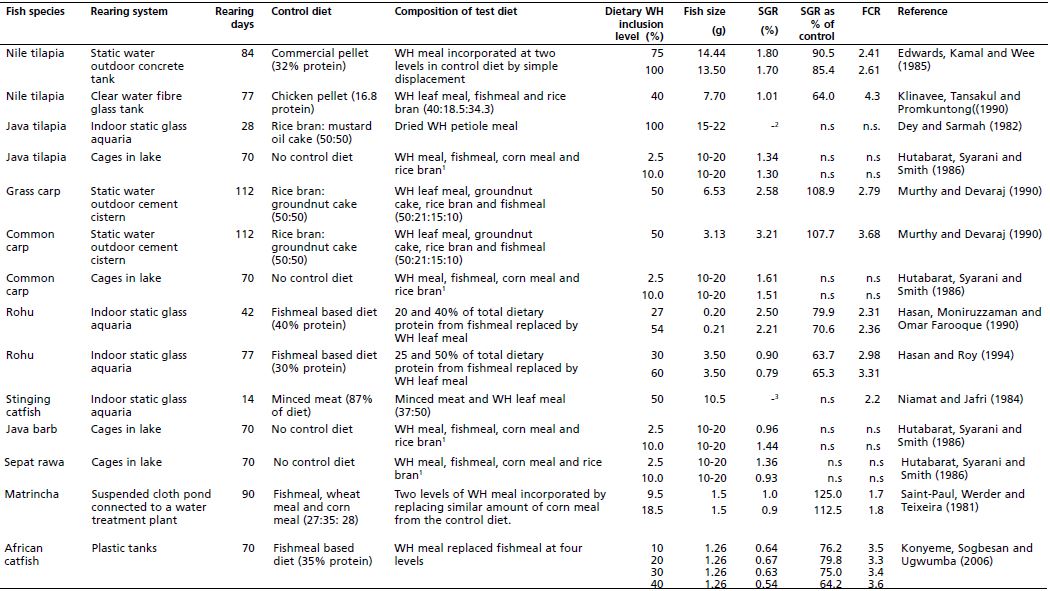
1 One test diet contained 2.5% WH meal with fishmeal, corn meal and rice bran in the ratio of 35.0:10.0:52.5. The other test diet contained 10% WH meal with 7.5% reduction of rice bran
2 SGR not reported. Consumption of control diet was 72%, while it was 70% for test diet. The performance in terms of weight gain was similar for fish fed control and test diet
3 SGR not reported. Fish fed water hyacinth diet registered around 20% gain in live weight in contrast to the group fed control diet where weight gain was about 8%
4.5.3 Composted and fermented forms
Composting or fermentation are techniques often used to reduce water hyacinth into forms utilizable for feeding livestock.
Composting is one of the most widely used processing techniques to prepare water hyacinth for use as a fertilizer or fish feed (Figure 4.3). A large quantity of inorganic nitrogen and phosphorus accumulates in the roots of water hyacinth, which makes it suitable as a compost or inorganic
Figure 4.3
Two farmers carrying dry water hyacinth to the pond side for preparation of compost pit (Mymensingh, Bangladesh)
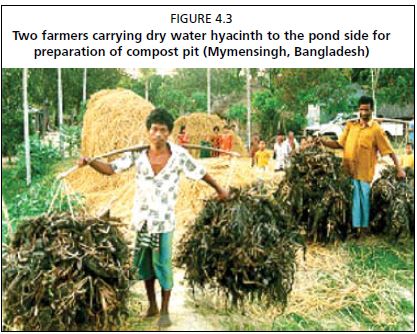
fertilizer. However, a major problem with the use of water hyacinth meal in fish diets is its relatively high crude fibre content. Fish do not appear to produce cellulase directly (Buddington, 1980) and their ability to maintain a symbiotic gut flora capable of hydrolyzing cellulose is limited. Fish often poorly accept water hyacinth leaf meal in pelleted diets. This has been identified as one of the major contributory factors for the reduced growth responses of major carp (L. rohita) fry by Hasan, Moniruzzaman and Omar Farooque (1990). Composting has been reported to increase the nutritive value and acceptability of water hyacinth. Edwards. Kamal and Wee (1985) made a comparison of the proximate composition of composted water hyacinth and dried water hyacinth meals and observed that while the crude protein levels were similar, the crude fibre and crude fats levels were approximately halved and the ash content approximately doubled by the composting process.
Preparation and use of composted water hyacinth
The most commonly used method for compost preparation is the Chinese method of surface continuous aerobic composting. Edwards. Kamal and Wee (1985) described the method as follows. Whole water hyacinth plants are cut into 2-3 cm pieces by a rotary chopper and sun-dried to an ambient equilibrium moisture content of about 20 percent on a platform elevated above the ground to facilitate drying. Compost is made by mixing dried and freshly chopped water hyacinth to give an initial pile moisture content of 65-70 percent; the mixture is made into a pile 2.5 m (length) x 2 m (width) x 1.3 m (height) and perforated bamboo poles are inserted for aeration. The mixture is turned occasionally to facilitate decomposition. The composting process is completed within 50 days.
Urea is often added at 2 percent to speed up the decomposing process. In this process it is suggested that the compost should be prepared by mixing water hyacinth, cow dung, urea and lime; water hyacinth and cow dung constituting the bulk of the ingredients while urea and lime are added at 2-5 percent of the total. The ingredients are kept in an earthen pit and arranged in layers with the top covered by polythene, paper or banana leaves (Figures. 4.4 and 4.5). Perforated bamboo poles are inserted for aerobic decomposition. However, compost preparation has been reported to be labour intensive and farmers are often reluctant to prepare compost for use as fertilizer. A simple compost preparation technique for use in fish ponds has been developed by the Mymensingh Aquaculture Extension Project (MAEP, Bangladesh) by using water hyacinth, cow dung, urea and lime (M.A. Mirza, MAEP pers com. 2004). Freshly procured whole water hyacinths are chopped into small pieces and dried for 1-2 days in sunlight. Sun-dried water hyacinth containing about 15-20 percent moisture is mixed with cow dung, lime and urea in the ratio of 88:10:1:1 (water hyacinth: cow dung: lime: urea). The ingredients are not kept in layers as traditionally used but are thoroughly mixed. The mixture is kept for decomposition in a pit near the pond side. The mixture is re-mixed every seven days to facilitate decomposition. The minimum area of the
Figure 4.4
A compost pit prepared with water hyacinth and cow dung (Mymensingh, Bangladesh)
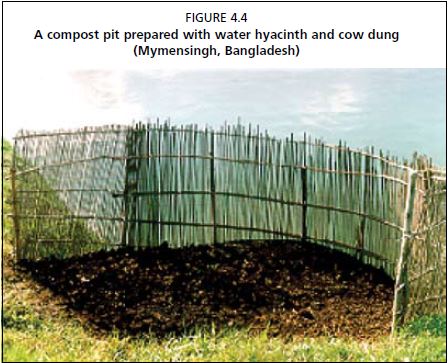
compost pit is 1 ft2, with a recommended depth of 4 ft to hold 70 kg of compost. The composting process is normally completed within two months. The recommended rate of compost application as suggested by MAEP is 18 000 kg/ha/year.
Compost is traditionally used as fertilizer in fish ponds in many Asian countries. Reports on its use as a fish feed are rather limited, however. Composted water hyacinth was evaluated as fish feed in pelleted diet for Nile tilapia by Edwards, Kamal and Wee (1985). These authors prepared four test diets by incorporating 25, 50, 75 and 100 percent of composted water hyacinth meal in a control diet that consisted of a conventional pelleted tilapia feed (32 percent protein). Good growth and feed utilization efficiencies were obtained with diets containing up to 75 percent composted water hyacinth, with no significant reduction in fish performance compared to the control diet. The specific growth rates varied between 1.96 and 2.15 for test diets while the SGR for control diet was 1.99. The FCR was between 2.18 and 2.57 for the diets with compost and 2.63 for the control.
Similarly Hutabarat, Syarani and Smith (1986) reported good growth by using composted water hyacinth in a pelleted feed for Java tilapia, Java barb and common carp in cage culture. However, these authors used only 10 percent as their maximum inclusion level. Edwards (1987) reported that good results were obtained in China by composting water hyacinth with silkworm faeces (or animal manure) and quicklime, or by composting the chopped water hyacinth with a small amount of salt or saccharified yeast.
The in situ decomposition of water hyacinth and its efficacy was studied by Mishra, Sahu and Pani (1988)
Figure 4.5
View of a compost pit in a corner of a pond (Mymensingh, Bangladesh)

in rearing ponds for Indian major carp (rohu, catla and mrigal) fingerlings. Fresh water hyacinth was applied at 300 kg/month/0.2 ha pond (1 500 kg/ha/month). The water hyacinth was killed in situ by using an aqueous solution of 2,4-D sodium salt and was allowed to decompose and disintegrate in the pond. The ponds were stocked at a rate of 3 000 fingerlings per ha (600/pond) and reared for twelve months. The addition of water hyacinth increased the fish production by about 52 percent as compared to the control pond where no additional input was provided. A net increase of 64.7 kg of fish was obtained by using 3 600 kg of fresh water hyacinth. The conversion ratio worked out to be ~55.7 for fresh hyacinth, while the FCR was about 3.3 on a dry matter basis, considering that fresh hyacinth contains about 6 percent DM.
Rohu (Labeo rohita) larvae were stocked at 1 million/ha by Sahu, Sahoo and Giri (2002) under three culture conditions: the application of water hyacinth compost (8 000 kg/ha), inorganic fertilizer (60 kg/ha), or no manure (control). While the total nitrogen and phosphate levels of the control treatment were 0.02 and 0.04 g/L, those in the compost treatment were 0.17 and 0.08 mg/l after 15 days of fertilization. In the inorganic fertilizer treatment the nitrogen level was elevated to 0.12 mg/l after 15 days but the phosphate level remained at 0.04 mg/l throughout the study period. The plankton volumes were 1.8, 1.2 and 0.4 ml/45 L in the compost, fertilizer and control treatments, respectively at the time of stocking of larvae. Significantly (P < 0.01) higher survival and growth were found in the compost treatment compared to other treatments.
Preparation and use of fermented water hyacinth
Fermentation is an age-old practice in food processing. In many cases fermentation has been reported to improve the nutritive value of cereal grains and oilseeds by increasing their protein efficiency ratio, digestibility and the availability of free amino and fatty acid contents. During fermentation, nutrient losses may occur as a result of leaching, destruction by light, heat or oxygen, or microbial utilization (Jones, 1975). Nevertheless, the loss of nutrients during this process is generally small and there may even be an increase in the nutrient level through microbial synthesis.
Edwards (1987) reported that water hyacinths were processed in China either mechanically (soaking, mixing, cutting, or grinding) or biologically for feeding to grass carp and common carp. The biological processing involved green storage and fermentation in ditches, tubs, or barrels under anaerobic conditions at 65-75 percent moisture after cutting into 6 cm strips and sealing by a 15 cm layer of dry grass topped by a 15 cm layer of moist soil; if the material was too moist it could be sun-dried or mixed with dry hay before sealing.
A simple fermentative treatment with cow dung and urea was evolved to process and utilize water hyacinth, as a feed and manure for carp culture by Olah, Ayyappan and Purushothaman (1990). Water hyacinth leaves were chopped into 5 cm pieces and mixed with 10 percent cow dung and 2 percent urea. The mixture was then kept in an airtight polystyrene bag and incubated at room temperature (27-32 ?C). These authors observed that a period of 2-3 weeks was optimal for cellulose degradation and to improve the nutritive value of water hyacinth. The crude protein content of the substrate increased from 13.1 to 18.1 percent of the dry weight during 18 days of treatment.
Olah, Ayyappan and Purushothaman (1990) fed fermented water hyacinth to catla, rohu, mrigal, silver carp and common carp in trials conducted in plastic pools for four (Trial 1) and eight week (Trial 2) periods. The stocking density was 19 and 5/m2 for Trials 1 and 2, respectively, with daily feeding rates of 50 g/m2. Silver carp and mrigal showed the best growth rates, followed by rohu. Food conversion ratios of 2.02 and 3.72 were obtained for Trials 1 and 2, respectively. Fermentation of water hyacinth may thus be a simple and efficient treatment for utilizing water hyacinths as a feed or manure in fish culture without the energy-consuming process of pelletization. Xianghua (1988) reported on the use of fermented water hyacinth as feed for grass carp. The plant was harvested, chopped, blended with a small amount of corn flour and fermented overnight. Good results were obtained in rearing grass carp beyond age II+.
El Sayed (2003) reported that Nile tilapia (Oreochromis niloticus) fingerlings (1.1 g) were fed with water hyacinth treated with various processes. Fresh dry hyacinth (FH), molasses-fermented hyacinth (MF), cow rumen content-fermented hyacinth (RF) and yeast-fermented hyacinth (YF) were incorporated into nine isonitrogenous (35 percent CP), isocaloric (450 kcal GE/100 g) test diets, as a substitute for wheat bran at 10 and 20 percent levels. Fish fed the control diet (wheat bran based) exhibited growth, feed conversion efficiency and production values significantly (P < 0.05) higher than those fed with water hyacinth based diets. There was no significant difference in the performance of fish between the fermentation products added at the 10 percent inclusion level. At the 20 percent inclusion level, the performance of fish was further reduced. Despite this rather discouraging result, it is interesting to note that significantly lower growth rate and feed utilization efficiency was found in fish fed with fresh dry water hyacinth than when fish were fed the fermented water hyacinth treatments.
4.5.4 Other processed forms
There are other processing techniques that are employed to increase the feeding value of water hyacinth for livestock, such as boiling, mashing and chopping.
For example, Gohl (1981) reported that boiled water hyacinth is used in Southeast Asia for feeding to pigs. The plants are chopped, sometimes mixed with other vegetable wastes such as banana stems, and boiled slowly for a few hours until the ingredients turn into a paste, to which oil cake, rice bran and sometimes maize and salt are added. The cooked mixture is good for only three days, after which it turns sour. A common formula is 40 kg of water hyacinth, 15 kg of rice bran, 2.5 kg of fishmeal and 5 kg of coconut meal.
In China, mashed water hyacinth is used as feed for Chinese carps (Z. Xiaowei, pers. com. 2003). Fresh water hyacinth is mashed into a liquid form with a high-speed beater and applied to ponds for carp fingerlings. The mesophyll cells are considered, rightly or wrongly, similar to phytoplankton. There is an additional means of using mashed water hyacinth as fish feed: water hyacinth pastes are mixed with rice bran and are fermented before applying to the pond.
Kumar et al. (1991) evaluated the nutritive value of mashed water hyacinth leaf for rohu spawn (1.9 mg). Mashed water hyacinth leaves were fed in the form of leaf extract. The hyacinth extract was prepared by crushing the leaves with water (1:5) in a heavy-duty mixer. The solution was sieved through a 1 mm mesh to remove the fibrous material. One or two percent common salt was added to the solution. The experiment was conducted for 30 days in 40 L glass tanks. Plankton dominated by rotifers and cladocerans were used as a control treatment. Hyacinth extract was provided at 100 ml/day to the experimental tank containing 120 spawn. The specific growth rate of rohu spawn fed with mesophyll cells was 8.59 while that for the control was 9.04.
Edwards (1987) reported the efficiency of three processing techniques applied to water hyacinth for use as fish feed and fertilizer from unpublished research studies carried out in the Asian Institute of Technology, Thailand. Water hyacinths were added to a series of earthen ponds stocked with O. niloticus in three forms: fresh whole plants that decomposed beneath the water in situ; freshly chopped water hyacinth spread on the surface; and composted water hyacinth. Extrapolated yields of 5 to 6 tonnes/ha/ year were obtained with all three treatments at the same dry matter loading rate of 200 kg/ha/day (about 3 kg TKN/ha/day).
Bolenz, Omran and Gierschner (1990) suggested the following treatment to avoid the problem of oxalate crystals (see section 4.5.1). The plants should be chopped into small pieces; this helps to eliminate trapped air and negate its ability to absorb water. Then the solid material should be separated from the soluble components in the juice by pressing and centrifugation. The solid phase will be washed with acid to remove the acid-soluble calcium oxalate. The juice may be concentrated, dried and used as a protein source. However, such elaborate treatments will probably not be cost-effective in preparing fish feeds.
4.5.5 Food conversion efficiency
Food conversion values of diets containing varying inclusion levels of dried water hyacinth meal tested for different fish species were included in Table 4.3. It can be observed that the FCR of these test diets varied between >2.0 and <4.0, with the exception of Nile tilapia (FCR 4.3), as reported by Klinavee, Tansakul and Promkuntong (1990) and Brycon sp. (FCR 1.7-1.8), as reported by Saint-Paul, Werder and Teixeira (1981). However, it is difficult to standardize an FCR from the available data because of the difference in fish species, water hyacinth inclusion levels, rearing systems and length of rearing. A summary of food conversion ratios for various fish species fed test diets containing fresh and processed water hyacinth is presented in Table 4.4. Apart from the pelleted diets containing dried water hyacinth meal, not much information on FCR for other forms of water hyacinth is available. However, what is available indicates that an FCR value of 3.0 is a reasonably acceptable level for fresh or processed water hyacinths.
Table 4.4
Food conversion ratio of fresh and processed water hyacinth for selected fish species
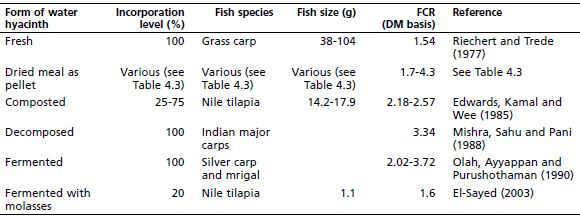
4.5.6 Digestibility coefficients
Several authors have reported the apparent digestibility coefficients of water hyacinth when fed to carps and tilapia. These varied between species (Table 4.5) and were influenced by the level of water hyacinth incorporation (Table 4.6). Lin and Chen (1983, cited by Wee, 1991) noted that protein from water hyacinth was poorly digested (58.9 percent) by grass carp. Similarly, Riechert and Trede (1977) concluded from their feeding trial with fresh water hyacinths that only 50-60 percent of the feed consumed were actually digested by the grass carp. Apparent protein digestibility (APD) of water hyacinths by Nile tilapia was reported by Pongri (1986, cited by Wee, 1991). He reported APD values of 49-65 percent and 46-65 percent for dried and composted water hyacinth when 37.5 percent of water hyacinth was incorporated in the diet. APD values of water hyacinth leaf meal for Indian major carps (rohu and catla fingerlings) were reported by Hasan and Roy (1994) and Nandeesha et al. (1991), respectively (Table 4.6). Digestibility coefficients decreased with increased dietary incorporation of water hyacinth. For rohu, APD values were 65 and 78 percent for 60 and 30 percent incorporation levels, while for catla it varied between 48 and 74 percent at incorporation levels from 45-15 percent. In nature, rohu fingerlings feed predominantly on vegetable debris and microscopic plants while catla are predominantly zooplankton feeders. Therefore, it is likely that rohu would be able to digest plant materials better than catla. In an earlier study with rohu fry (mean weight 0.2 g), Hasan, Moniruzzaman and Omar Farooque (1990) reported the APD of water hyacinth leaf meal to be 55 and 60 percent for 54 and 27 percent levels of dietary water hyacinth inclusion levels. In contrast to these results, Ray and Das (1994) reported much higher APD value (94.0 percent) of water hyacinth leaf meal for rohu fry (3.6 g). Similarly high APD values of water hyacinth for grass carp and common carp fry were reported by Murthy and Devaraj (1990) (Table 4.5).
From the foregoing discussion, it is difficult to draw any definite borderline between digestibility coefficients of carps and tilapia. However, it is apparent that digestibility coefficients are mainly dependent on the level of dietary incorporation. For all practical purposes, the protein digestibility of water hyacinth may safely be taken as 70-80 percent at 15-30 percent dietary incorporation levels, while it may be around 50-60 percent at incorporation levels of 45 percent or above.
Table 4.5
Summary of apparent nutrient digestibility coefficients of water hyacinth for selected fish species
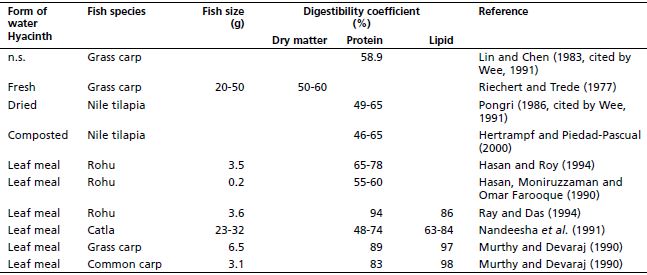
Table 4.6
Apparent nutrient digestibility coefficients of water hyacinth leaf meal for two carp species at different dietary incorporation levels
